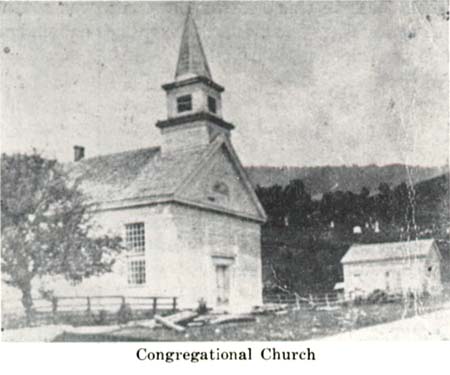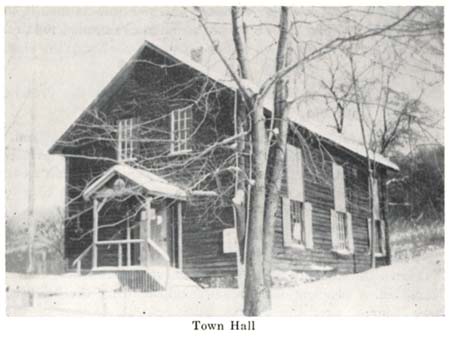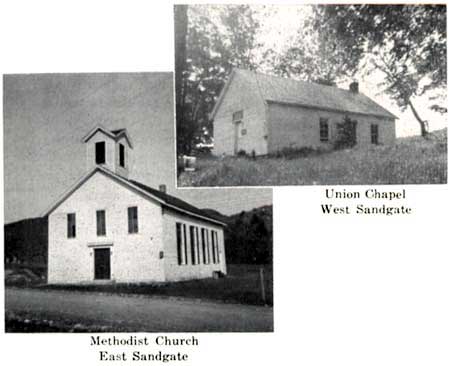
CHURCHES
Congregational Church
The first church to be established in Sandgate was the Congregational, known also as the "Meeting House." Although the Rev. James Murdock was ordained and installed January 17, 1782, and the list of membership commences in 1782, the church building was not erected until 1790.
There is evidence that building had probably been commenced earlier, for records of Proprietors' Meetings show they were held at the "Meeting House," but due to the scarcity of money it must have been a slow process. In 1783 an Act was passed by the Legislature "to enable Towns and Parishes to erect proper Houses of Worship and support the Ministers of the Gospel." This provided for the levying of taxes for building churches, voting settlements to ministers, and granting their annual support; but exemption might be granted to a person who held religious opinions differing from those of the denomination which was to benefit as a result of the tax voted if a certificate were furnished, signed by some minister or church official of the denomination with which the dissenter was affiliated. In Sandgate the Congregational Church was to benefit by this law, and the Rev. James Murdock was voted a salary of 50 pounds a year.
We are indebted to Miss Florence Hurd of Cambridge, New York, for the use of the church Vital Statistics records, also the following:
"The first Church to be built in Sandgate, Vt. was begun in March 1790 by the members who called themselves 'Proprietors.' It was put together with loving care and prayers that the 'Lord would long bless this labour of love to his people and to the salvation of many souls to God.'"They kept a record of materials and food used during the building as follows:
Labour - 5 & 6 Pence a day
Work with oxen Twine Wheat Work with team Lath Beef Timber Paint Pork Nails Putty Butter Shingles Oats Beans Rye Cheese
"There must have been many more items used before it was finished for it was a beautiful edifice and the Lord seems to have been the Architect. It was typical New England in design.
"There is every evidence that a 'society' was formed before the Church was built for they ordained and installed the Rev. James Murdock as the first Minister in 1782.
"There is a bit of Hurd Family history in connection with this Congregational Church. On Oct. 17, 1813, Abigail Parker aged 17 and Josiah Hurd aged 21, son of Lewis Hurd (one of the original 'Proprietors' of the Church) were united in marriage before its altar. Exactly 75 years later, Oct. 17, 1888 Abigail was placed before the same altar for her funeral service. Abigail and Josiah lived together 72 years.
"The Church stood true and straight for over a hundred years - and when it was finally demolished, dynamite was necessary to tear it asunder. "For many years, looking down from the burial ground on the hill the outline of the foundation of this Church could be seen.
(signed) Florence Hurd"
In 1796 Andrew Buckingham, Abner Hurd, and Reuben Thomas were chosen "to mark{ out Pue Ground in Meeting House" and it was "voted to set up Pue Ground at Vendue." A special meeting was called in December of 1796 "to see if grant rate or some other measure to finish Meeting House" and at another special meeting a year later "voted to sell Pine grown in Meeting House land and see that money is laid out to finish Meeting House." It is said the church cost $1500 to complete. 24 In 1807 a transfer was made by a member for $8.00 of his Right to "one-third of the Pew and Pew Ground, which is the first pew in the Square Bay in said Meeting House, on the Right hand from the Double Dore."
Capt. Lewis Hurd devoted much of his time to the Church, and when repairs were needed in 1846, in spite of his age, gave freely of his services, and himself contributed $450. Photograph on Page 33 was taken while repairs were in progress.

The following copy of a memorandum gives an insight to the history of the church.
"Sandgate August AD 1846. Lewis Hurd Now in my 87 year of my Age have this day bin Looking over these old Meeting hous Papers and Find that we begun to build that hous in March 1790. I was one of the Proprietors and Committee and now the ownley one that is Left to my knowleg on the Earth that was a man grown that took a part in building the hous; and Now in June 1846, am the treasurrey and the Principle Proprietor Repairing the old hous which I Consider as my Last Publick Service, and my Earnest desire and Prayr to God is that the Lord would long Bless this labour of Love to this Peopl and to thine own Glory and to the Salvation of many Soles to God.
Amen. Lewis Hurd"
Capt. Lewis Hurd died Dec. 18, 1848. Miss Florence Hurd is his great-great-granddaughter.
The church was located south of and alongside the present District No. 2 schoolhouse, which shows in the photograph. The first schoolhouse in this District, however, was south of the church. The first burying ground, known now as Sandgate Center Cemetery, lies on a hill beyond.
In 1798 a meeting was called "on 16th of October next at 3 o'clock P. M. at the School house in Terry Brook District" to organize an Episcopal Society. The subscribers were Aaron G. Ferris, who was elected Clerk,
John Hurd
David Turtle
James Bristol
Theophilus RansomTheophilus Hurd
Cyrus Hurd
James Skidmore
George Peck
The name of the church was determined to be "St. Matthew Church," but there is no evidence that a church was built, nor any record of further meetings or services held. It may be that the membership combined with St. James Episcopal Church in Arlington, an adjoining town. Rev. James Nichols was the minister of St. James, and certificates are recorded signed by him, showing that the "minister's rate" had been paid to him.
(Town Hall)
There is no record when Methodists in the town of Sandgate organized. Early 1800 Congregational Church records show a few Methodists on their church roll--
Zachariah and Polly Hurd
Ira and Miriam Hurd
Titus and Betsey Woodard
Lavina Spafford
Levi and Anna Randall
Aaron and Polly Hamilton
The Philip Embury Church, second Methodist Church in America and the first north of New York City, was erected in 1788 at Ashgrove, New York. Rev. Freeborn Garrettson, presiding elder, described the new 34 x 46 foot church as the most elegant one according to its size that he knew of. In 1803 the church was enlarged by adding 14 feet to its length. The men and women of the congregation were divided by an aisle running through the middle of the Church. At the left of the aisle, steps led to a pulpit 4 x 5 feet. A bare pine board was provided for the minister to sit on, and another for the Bible and hymn book. Along three sides was a gallery divided by an aisle. Women brought candles to the evening services and put them in candlesticks suspended from the ceiling.
In 1832, when another and larger church was erected in Ashgrove, the old church building was moved to Sandgate and a piece of land deeded to the "Trustees of the Methodist Episcopal Church in Sandgate, Ira Hurd, Joseph Snow, Jr., Levi Randall, James Hamilton 2d and Lay Hurd" by Naham Brigham. For nearly 30 years it was used as a Meeting House; then, as it needed repairs, the Trustees (then William Lay Hurd, R. P. Barber and Rossiter Randall) in 1860 quit-claimed it to the Town, provided the Town would make the needed repairs. It was to be used as a Town House except on the Sabbath, when it was needed for meetings.
In 1878 a new church was erected. This is the present Methodist Church.
The old building continued to be used as a Town Hall until about 1937, but gradually fell into disrepair. After that its dangerous condition, combined with a difference of opinion as to whether it should be repaired and whether the town's title to it was good, led the town to hold its meetings and elections in rented buildings.
When Mrs. Celia II. Stickle of Indianapolis, Indiana, who was born in Sandgate in 1870, and whose grandfather, James Hamilton, a resident of Sandgate, helped bring the building here, learned that the Fourth Quarterly Conference of the Methodist Church had voted to take down and dispose of the old landmark, she was determined to save the building. She started a campaign, arguing that Sandgate, Bennington County, and Vermont should not allow this historic old building to die. She gave $100 toward the work and raised enough money for emergency repairs. A slate roof was put on, about 200 new panes of glass placed in the building's unusually large windows, which were almost gone, a stone foundation was relaid, and new sills put under the building.
Her energy had kept the building from falling, but its interior was still in a sorry state. The town continued meeting elsewhere, while Mrs. Stickle personally paid fire insurance premiums and urged Sandgaters to come back to their old home. As a result of dissension in town, Sandgate found itself without a place to hold its March 1945 town meeting. Mrs. Stickle seized this opportunity to stress the importance of making something useful, something living, of this old landmark, and in a letter to a Selectman stated: "The town needs the building and I think the building needs the town."
Town meeting of March 1945 was held in the old building, whose layers of three floors were rotten and whose walls were dropping plaster. A committee was named to consider future possibilities; renting a hall, building a new one, or renovating the old landmark. A special meeting was called for June, at which time the committee recommended renovation; $500 was voted for the work, to this was added $144.50, the unspent portion of Mrs. Stickle's emergency fund, and $200 was donated by Mr. William Tefft Schwarz. Actual work was not undertaken until it was satisfactorily established that the town's title to the church would not be challenged. This came in the form of a resolution passed by the Troy Annual Conference of the Methodist Church at Glens Falls, New York, on October 3, 1945.
The principal renovation consisted of substitution of one sound floor for the rotten old ones; substitution of interior insulation board for the plaster; two doors to comply with safety regulations; a new stoop in front; electrification of the building; and new braces to strengthen the entire structure. Although Mrs. Stickle did not live to see the completion of the work, she had been in Manchester in 1945 visiting relatives and helped to establish validity of the title to the building, and it must have been a great source of satisfaction to know that the work in which she was so interested was being done.
In 1958 further repairs were made to the Town Hall; siding replaced where needed; windows repaired; and the building painted - all at a cost of $1200.
Strangely enough, Town Hall is located about where the first Minister's Right was laid out in 1782, when early surveys were made in Sandgate.
Over the entrance to building is a replica of the State Seal of Vermont, painted by Mr. William Tefft Schwarz.
Methodist Episcopal Church
In 1877 a new Methodist church was planned and building commenced. The land, opposite District No. 2 school, was deeded to the trustees in 1878. Excerpts from a letter to Mrs. Ralph Tudor, written in 1957 by Mrs. George H. St. Mary of Greenwich, New York, give some interesting facts of construction: --
"My grandfather, John Barber, son of Royal P. Barber who is buried on the hill above the church, had the contract to build the church. He owned and operated a large saw mill at Beartown and sawed and finished all the lumber used in that mill. He drew up the plans for the church and supervised the construction hiring for a carpenter W. J. Cruikshank of Salem and his men. The plans called for two square Spruce timbers 12x12, 44 ft. long and two more 8x8, 64 ft. long. This required a search of the woods to find trees large enough to supply such timbers. A man by the name of Jerome Wheeler located these trees, he was an expert woodsman and traveled many miles through the woods before he located the big spruces. The carriage would not carry timbers that long to the saw, so an extension had to be built and the men had to push the carriage by hand up to the saw. My uncle was between 9 and 10 years old at the time but remembers the proceedings perfectly. Several sheds were also built back of the church, which are now gone.
"A few years after the church was built my grandfather moved into Sandgate proper right next to the church and lived there when my mother was born."
The cost of construction was about $2500, and seating capacity between 250 and 300. The church was dedicated on October 30, 1878, by Rev. Gideon H. Townsend. From records of Mrs. Fred W. Lomberg, Sr.:
"According to announcement the new Methodist Church in this place was dedicated on Wednesday, October 30, 1878. The day, as to weather, proved to be a day of days, the winds blowing a hurricane, and the rain descending in torrents 'and the floods came and beat upon that Home and it fell not.' "
Previously, on September 5, 1878, the church bell had been installed:
"Friday was a field day for the people of Sandgate, the occasion being the raising of a church bell to the belfry of the new Methodist Church of this place, in connection with a picnic. The bell was a presentation of Dr. A. J. Woodward.
"Under a cloudless sky the citizens commenced to collect at about 9 o'clock A. M., and by 11 o'clock a large concourse of people had assembled from this and other adjoining towns. The raising was successfully accomplished without accident. The bell was tried and was not found wanting, the tone being clear and far reaching. Thanks were extended to Messrs. Cruikshank and MacFarland, the contractors, who were kind enough to raise the bell without compensation, and also to the Bentley Band, which favored us with the music, and contributed largely to amusements of the day."
There is no record of the original membership roll. The minister in 1880 was Rev. H. Townsend. From 1918 to 1920, the church was closed, opened again one year, then closed for seven years; but, since 1928, continuous services have been held. The longest tenure was that of Rev. M. Hammond, who served West Arlington and Sandgate parishes from 1943 - 1956. He retired because of ill health and died soon after. He was greatly esteemed by the members of his congregation.
Rev. C. R. Sumner conducted services from 1956 - 1960, when Rev. Kenneth McCrea took over the ministry. While the church has a very small membership at the present time, it is not in debt. Each year during July or August a special service is held on "Old Home Day." Old and new residents attend, people of all denominations. Ice cream and cake is served, then the service is opened. There is music, and always visiting speakers. With the generous contributions on Old Home Day the Church is able to continue in Sandgate.
This year a special service is planned for Old Home Day in commemoration of the Bicentennial of the Charter granted to the town of Sandgate.
This chapel was built and dedicated in 1900. The first minister was the Rev. Taplin Winslade.
Stephen S. Beach, brother-in-law of William N. Lincoln, was a carpenter, and supervised the erection of the building. The greatest part of the work was done by volunteer labor. Funds were contributed by many Sandgate residents, as well as by their friends from surrounding towns. Contributions amounted to over $500.
On January 23, 1901, Stephen S. Beach leased the land on which the church stood to the West Sandgate Union Chapel Society -- one of the conditions being that "any and all religious denominations shall at any and all times have the free and equal right to use said chapel for religious purposes."
Services continued without interruption until about 1920. From that period, services were held, on and off, until 1954, the last minister being the Rev. Donald Hunt. 25
24. Hamilton Child, Gazetteer and Directory of Bennington County, 1880-1881 (Syracuse, N. Y., 1880), p. 181.
25. Mrs. Stephen D. Lincoln and Miss Vivian J. Smith, Sandgate, Vt. Church records.
Printed by
Farnham & Farnham
Shaftsbury, Vermont
1961

